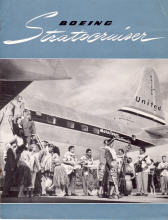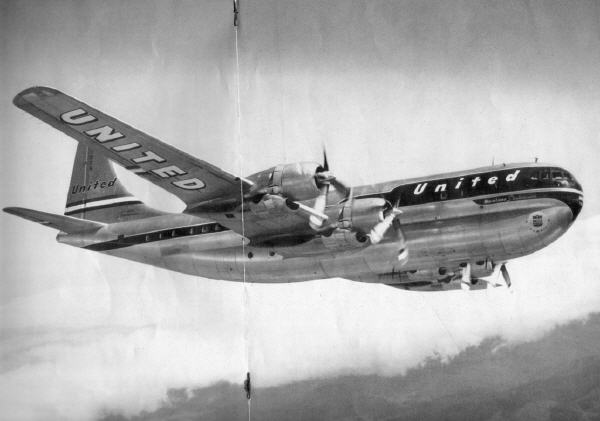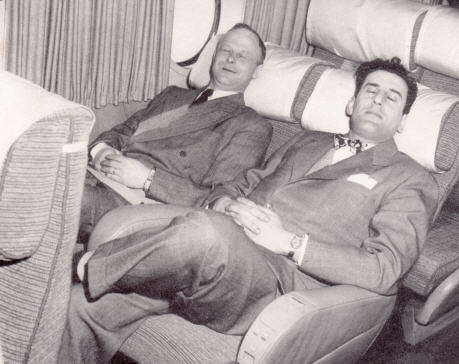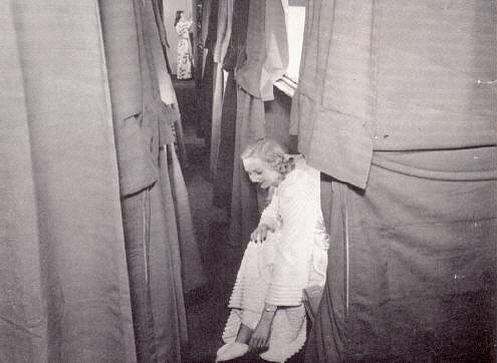






From «Boeing Magazine», October, 1949











 1 — Room service — passengers in the aft luxury compartment of United Air Lines' Boeing Stratocruiser dine in private. The compartment carries three to five passengers, is ideally suited for one-family stateroom.
1 — Room service — passengers in the aft luxury compartment of United Air Lines' Boeing Stratocruiser dine in private. The compartment carries three to five passengers, is ideally suited for one-family stateroom.
2 — A-a-ah! It's great to get up in the morning — after a good night's rest in the roomy, comfortable berths of UAL's Boeing.
3 — Main cabin is divided into two well defined areas, fore and aft of the galley.
4 — Food service is efficient from UAL's galley, located amidship in Stratocruiser.
5 — Curtains establish Hawaiian motif in lower-deck lounge, designed for relaxation.


 Newest chapter in an old, old story at United Air Lines is the Stratocruiser: progress spurred on bay many Boeing airplanes.
Newest chapter in an old, old story at United Air Lines is the Stratocruiser: progress spurred on bay many Boeing airplanes.
On July 1, 1927 — little more than a month after Lindbergh0s Paris flight — a Boeing 40-A took off from Chicago, San Francisco-bound, to inaugurate the first transcontinental airline service. It bore the insignia of Boeing Air Transport, predecessor division of United Air Lines. It carried two passengers but, like the pony express, was designed primarily to carry the mail. Time between Chicago and San Francisco was twenty-seven hours.
Sometime early in 1950 a Boeing Stratocruiser will take off from San Francisco for Hawaii, inaugurating a new luxury service that is transcontinentalplus. It will promptly establish new standards of speed and luxury on the over water lap of United Air Lines' famed aerial Main Line from the Atlantic Coast to Honolulu. Passengers who start the trip at New York will be donning leis on Hawaiian soil just twenty-three hours and fifteen minutes later.
United has ordered seven of the giant double-deck Stratocruisers for its Hawaiian run. Thus, the relationship between a leader in aircraft manufacture and a leader in air transportation has been renewed — a relationship that began in the pioneering days of 1927 an has helped write airline history ever since.
It is logical that United should put the Stratocruisers on the vital Hawaiian link of its 10,665-mile airline network. An over-water hop of 2400 miles demands the most dependable of airplanes. A route designed for particular people — largely for people who are looking for something extra in vacations — demands something extra in aircraft and in passenger accommodations.
Accommodations? In 1929 Boeing Air Transport put new planes on the San Francisco-Salt Lake section of its U.S. Air Mail Route No. 1 — Boeing Model 80s, first planes with honest-to-goodness passenger accommodations. the accommodations took care of twelve passengers, but did not eliminate the feeling of the air traveler that he was “roughing it.” Nonetheless, United's predecessor already was grasping the vast potentialities of carrying r. and Mrs. Public by air. The notion still persisted among many pilots, however, that the passenger was strictly secondary to the mail.
On United's Boeing Stratocruiser the passenger will not be secondary to anything. While he is aboard, it will be his airplane. It was designed by Boeing with him in mind. Its interior appointments, planned for UAL by Zay Smith Associates, were designed for him, too.
An important bit of reasoning on which United's philosophy of passenger comfort is based, for instance, is the belief that Americans like plenty of elbow room, wherever they are. The 6000odd cubic feet of space in the Stratocruiser main cabin provides a lot of room any way you look at it. The way United looked at it, the Boeing Stratocruiser presented them with the world's finest opportunity for following their philosophy.
United has achieved the effect of several separate “rooms” by dividing the Stratocruiser's main cabin into two welldefined areas. A third “room” is provided in the semi-private compartment, forward of the dressing rooms. A fourth separate area embraces the lavishly-appointed private stateroom aft.
To provide this roomy comfort, the airline willingly sacrificed some of its potential ticket sales. It preferred to furnish deluxe accommodations for 55 passengers rather than limited space for a larger number. Even so, 55 is quite a crowd for a transocean flight.
Passengers boarding United's Mainliner Stratocruiser can have no doubt as to their destination. The mere act of stepping aboard gives the immediate sensation that one already has set foot on Hawaiian soil.
The Hawaiian theme dominates the ship's entire interior. Bulkheads have trim strips of bamboo and are faced with mats woven from the products of the pandanus, a native Hawaiian tree. The tropical touch is carried into the lowerdeck lounge, with curtains featuring an abstract design of fish and pineapples.
On May 15, 1930, Boeing Air Transport introduced the world's first airline hostesses. They immediately became a popular asset to the coast-to-coast Boeing 8Os and dining aboard an airliner became, for the first time, a pleasure.
Aboard UAL's Mainliner Stratocruiser passengers will enjoy cuisine prepared by continental-trained European chefs, each with more than thirty years' experience in food preparation. It will be served from a galley located amidship, rather than aft as on most versions of the Stratocruiser. This arrangement better enables United to divide the plane into fore and aft “living rooms,” and to serve both areas with speedy efficiency.
Regardless of interior arrangement, however, the Mainliner Stratocruiser remains basically the same airplane as all the great Boeing double-deck transports. Four Pratt & Whitney Wasp Major engines, with 14,000 harnessed horses, will carry it toward the Islands at more than 300 miles per hour. Pressurization throughout will enable passengers to look down upon the Pacific from an altitude of 15,500 feet while breathing sea-level air. Flying at 25,000 feet, the passengers will enjoy a “cabin altitude” of only 5500 feet. Taking the ocean route aboard the Stratocruiser, they will be flying the best -the ahead-of-its-time product of research, engineering and construction that has provided tomorrow's planes for all the todays of thirty years of aviation.
 In 1933 United Air Lines (formed in 1931 from Boeing Air Transport, National Air Transport, Pacific Air Transport and Varney Air Lines) put into the air the Boeing 247. This was the nation's first all-metal, low-wing, twinengine transport-so far ahead o f its time that its design pattern was destined to be followed by the great airliners o f a decade and a half hence. It carried ten passengers, baggage, mail and express at UNITED almost three miles a minute, reducing coast-to-coast time to nineteen and a half hours.
In 1933 United Air Lines (formed in 1931 from Boeing Air Transport, National Air Transport, Pacific Air Transport and Varney Air Lines) put into the air the Boeing 247. This was the nation's first all-metal, low-wing, twinengine transport-so far ahead o f its time that its design pattern was destined to be followed by the great airliners o f a decade and a half hence. It carried ten passengers, baggage, mail and express at UNITED almost three miles a minute, reducing coast-to-coast time to nineteen and a half hours.
 Across the years, United has sought to reduce the time along its Main Line, to bring the Atlantic seaboard ever closer to the Pacific. With the advent of the Boeing Stratocruiser, it will be an even twenty-four hours from Washington, D. C., to Honolulu, twenty-five and a quarter hours from Boston.
Across the years, United has sought to reduce the time along its Main Line, to bring the Atlantic seaboard ever closer to the Pacific. With the advent of the Boeing Stratocruiser, it will be an even twenty-four hours from Washington, D. C., to Honolulu, twenty-five and a quarter hours from Boston.
In the process of reducing a continent to a hop, skip and a jump, UAL has constantly expanded its operations. Since 1939 it has more than doubled its route mileage. Its network of airlanes now reaches into twenty-two states, the District of Columbia and British Columbia, in addition, of course, to Hawaii. It serves 80 cities and provides connections to 1650 others in the U. S. and abroad.
Hub of United's aerial web is its operating base in Denver, established in 1948. From here are controlled all flight operations, maintenance, engineering, communications, and passenger service activities, providing effective coordination throughout the entire system.
Another important cog in the UAL machine is its multi-million-dollar “pushbutton” maintenance base at San Francisco, where more than eighteen Mainliners are overhauled each month.
A far cry, these developments of postwar science and planning, from the precarious days of the daring “40s,” which were really not so long ago. The progress has been equivalent to many decades in most fields of transportation. And much of the way, from “40” to Stratocruiser, it has been linked with the name Boeing. Perhaps the greatest single stride of them all will be accomplished when the first Mainliner Stratocruiser heads out across the Golden Gate, with distant Hawaii just a few pleasant hours away.
![]() High-level Stratocruiser flight means more than fast and smooth travel, for luxury is a keynote of the new queens of the skies.
High-level Stratocruiser flight means more than fast and smooth travel, for luxury is a keynote of the new queens of the skies.
To achieve a new high in travel luxury, take a railway chair car (the most modern one, please) and add a dining car which is famous for the excellence of its cuisine. Blend in a soundproofed sleeping car with superblyappointed, convenient dressing rooms. Then add a handsomely-decorated clublounge car.
Mix them together.
We have now combined all the known elements of comfort offered by what up until now has been generally accepted as the most comfortable form of land travel.
To what we already have assembled, add the gentle atmosphere of a perfect summer evening, being sure to filter out the dust and smoke.
Now provide the courteous attentions of a deft steward or a gracious stewardess. Combine a11 the foregoing items into a single, strong package, tie them to the heels of 14,000 surging horsepower and whisk them through the skies at 340 miles an hour.
The result is the Boeing Stratocruiser, the most comfortable method yet devised by man of getting from one place on the earth's surface to another (if we do say so ourselves) — and getting there with a minimum of wasted time and lost motion.
FOR CODDLING
Comfort has not been treated casually in the Stratocruisers. The designers were aware that today's airline travelers take both speed and comfort for granted — they expect it. So the men behind the Stratocruisers set out to make passengers more than merely comfortable. They set out to coddle them.
The 6600 cubic feet of interior space in the huge “inverted-figure-8” doubledeck Stratocruiser fuselage gave them plenty of room to work with.
They used it to encase in the Stratocruiser the greatest possible number of luxurious refinements that can contribute to passenger comfort. And when they were through, there was still an abundance of room.
That's the passenger's first impression of Stratocruiser interiors — roominess. And the impression is not misleading. There is room to stretch out and relax, there is room to walk around or amble down a thickly-carpeted, circular staircase to the lower-deck lounge.
This “ambling space” is an important feature of Stratocruiser comfort. Nevertheless, the designers of the big new ship figured that most travelers will spend much of their time sitting down. On this basis, they set out to design a chair — not a mere “seat” — which would be as much of an advancement over previous types as the Stratocruiser itself is an advancement over previous transport airplanes.
They started with the human anatomy itself. Drawings supplied by the Smithsonian Institution yielded data on chair contours which would provide maximum relaxation. These were supplemented by scores of tests with sitters, large and small. Thus the Stratocruiser chair adapts itself to the occupant — the occupant does not have to adapt himself to the seat, with resultant fatigue.
FLOATING COMFORT
Live-rubber chair supports eliminate even the most minute residue of vibration which has not already been engineered out of the airplane itself. Foam-rubber cushions mounted on nylon webbing literally “float” the passenger on millions of tiny air cells, regardless of his weight or dimensions.
With such a chair, it was logical to assume that passengers might be reluctant to leave it, even to enjoy the Stratocruiser's ample leg room. So Boeing builders made it unnecessary to do so. On the chair arm, they mounted (1) chair adjustment controls, (2) individual seat-light switch, (3) ash tray, (4) call button for the stewardess, (5) “occupied” sign and (6) an attachment for a food or writing table.
The same “deep and dreamy” cushions that cradle the seat passenger by day will provide soft sleeping for the berth passenger by night. And these berths are seven inches wider and four inches longer than standard Pullman accommodations.
To these elements of comfort, Boeing added a man-made climate that is closer to perfection than anything that the most eager chamber of commerce could desire.
The Stratocruiser is altitude conditioned so that cabin pressurization automatically goes into operation whenever the plane leaves the ground. Up to 15,000 feet, pressure will show no change from sea level. Passengers on flights at this altitude will feel no ear effects whatsoever during ascent and descent. And at higher altitudes there will be no noticeable effects. At 20,000 feet, cabin conditions will climb slowly to the equivalent of only 3000 feet elevation. At 25,000 feet, a passenger is subjected to an atmosphere similar to that of Denver.
HIGH FLYING
In addition to pressurization for passenger comfort in smooth “above-the-weather” altitudes, the Stratocruiser airconditioning system provides about four times the air flow available to passengers in competing transport airplanes.
Cabin air is circulated at a rate which provides a complete change every two minutes. The air is heated or cooled, to compensate for outside conditions ranging from 60 degrees below zero to 85 degrees above — and the cabin temperatures stay at a comfortable 70 degrees at any point in this 145-degree range of outside temperatures. This ventilating system works on the ground as well as in the air.
The air is not only kept constantly fresh, but it is filtered. Odors, tobacco smoke and dust just simply disappear inside the Stratocruiser. Heating or cooling is passed between dual walls and windows. It keeps the windows clear. It keeps the walls warm or cool. After passing through the walls, the fresh air sifts into the cabin uniformly at all points through the millions of “pores” in the ceiling fabric, thus making drafts impossible. It gets used for 120 seconds and is drawn away silently through wall grills at floor level.
Airlines that will be operating Stratocruisers on their “blue-ribbon flights” will find themselves in a position to serve more delicious meals aloft than ever before. A Stratocruiser passenger who has been amazed at the amount of room and comfort all around him will not be surprised if the meals he receives are the best he has ever eaten on any trip.
This meal-time contribution to passenger comfort is made possible by a large, superbly equipped and efficiently-arranged galley. Two features for passenger appeal: meal will be taken fresh from hot ovens and coffee will be fresh-made aboard.
Adding a final luxury to the Stratocruiser are two six-passenger dressing rooms. These are as convenient, plush and heavily mirrored as the dressing rooms of a swanky Manhattan club.
The power which enables Stratocruisers to take off with only three of the 3500horsepower Pratt & Whitney Wasp Major engines, or climb to 15,000 feet with only two engines, is the same power that carries them to upper-level smooth riding altitudes.
The high wing loading (more load per square foot of wing area) made possible by 14,000 horsepower causes the new queens of the airways to ride “through” rough air instead of buffeting around in it.
The basic wing and tail surfaces and perfected aerodynamic design of the war time Boeing Flying Fortress and Superfortresses have been incorporated into the Stratocruisers. Thus the design that made the B-17s and B-29s stable, steady “bombing platforms” is being used to give the Stratocruisers the smooth stability in flight without which many of the other comforts built into them might lose some of their appeal.

 TOP LEFT — Comfort is the keynote inside the Stratocruiser. It's easy to drop off to sleep in deeply-cushioned chairs as the plane devours distance at 340 miles an hour, far above “rough air”level
TOP LEFT — Comfort is the keynote inside the Stratocruiser. It's easy to drop off to sleep in deeply-cushioned chairs as the plane devours distance at 340 miles an hour, far above “rough air”level
TOP RIGHT — Stratocruiser passengers suffer no ear discomfort at high, smooth altitudes: “Altitude conditioning” keeps pressure in the cabin comfortable. It is controlled by flight engineer.
LOWER RIGHT — There won't be any rest lost when passengers tuck themselves into Stratocruiser berths. They are roomier than standard railway sleeping-car berths. Ladders reach the upper berths.


The charming powder room of the new Boeing Stratocruiser delights every woman who sees it. Amply roomy, it has twin vanity sofa, a full-length mirror, two lavatories and a separate dental basin. It's an invitation to glamour.
Here, as in the superbly appointed men's dressing room, where six passengers can be accommodated comfortably, you get an idea of the scores of ways in which the Stratocruiser adds to travel enjoyment.
You'll hardly be aware of this airplane's 340-mile-an-hour speed, so smooth and quiet is its flight. You'll cruise above most weather in the calm upper air, yet feel no inconvenience. For the matchless altitude-conditioning system, developed by Boeing after ten years of pioneering, maintains normal,, comfortable cabin pressure even at the highest flying levels.
Above all, you'll enjoy the spaciousness of an airplane in which you can move about freely, and relax, if you like, in the luxurious lower-deck lounge.
The Stratocruiser inherits all the dependability, aerodynamic advancements and structural stamina gained from 30 years of Boeing research, design and engineering.
Why have these forward-looking airlines chosen Boeing Stratocruisers as the new queens of their fleets? Among the reasons are:
